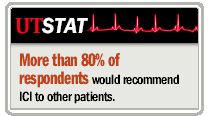Article
Post-radical prostatectomy patients report satisfaction with injections
Men who turn to intracavernosal injection (ICI) therapy following prostate surgery can generate a satisfactory rigid erection with as few as five practice (trial) injections, according to studies presented at the 2008 Fall Scientific Meeting of the Sexual Medicine Society of North America.

Men utilize ICI therapy if they fail to respond to oral phosphodiesterase type-5 (PDE-5) inhibitors, if they cannot tolerate the side effects associated with PDE-5 inhibitors, or if these agents are not potent enough to produce sufficiently firm erections.
In a study from the Lahey Clinic in Burlington, MA, researchers showed that most men who undergo prostate cancer surgery in a prospective examination required five or fewer injections to have a satisfactory erection.
All study patients (mean age, 60 years) had undergone bilateral radical nerve-sparing prostatectomies. The average time of the intervention was 15.5 months after surgery, with the majority (92%) less than a year after surgery. The baseline International Index of Erectile Function (IIEF) score was 11. Diabetes mellitus was present in 4% of the population, hypertension in 25%, hyperlipidemia in 48%, and coronary artery disease in 8%.

'Limited' side effects
In the final analysis of the 171 patients, the average amount of injection medication was 35 units. About one-third (32.7%) of patients needed three or fewer ICI attempts, and 39.2% needed four or five ICI attempts to titrate to an erection sufficient for penetrative sexual relations. Three of the patients required 10 or more injection titration attempts. The mean post-injection IIEF score was 27.
"The injection therapy was extraordinarily successful," Dr. Bennett said. "The overwhelming majority of men were able to get an erection that they could use in the bedroom."
The side effects of ICI are limited, he said, with patients experiencing mild events such as pain, bleeding, and bruising, which can be controlled with direct pressure applied to the injection site.
"The biggest potential problem with penile injections is priapism," Dr. Bennett told Urology Times. "Fortunately, none of our patients experienced a priapic episode during this study. About 5% of patients have penile pain, and that is due to a component of the injection medication. When that happened, we switched patients to a weaker medication that does not have that component."
High patient satisfaction
The efficacy of ICI therapy corresponds to a high level of patient satisfaction with the treatment, as reported in a second study, a retrospective review of patients who have taken injection therapy for long-term management of ED. A total of 262 respondents to a mail-in questionnaire indicated a mean duration of 8.1 years of therapy.
The majority of respondents (86.7%) said they would recommend ICI, consisting of Trimix or papaverine plus phentolamine (Bimix) therapy, to other patients. Treatment satisfaction by patient report and the Erectile Dysfunction Inventory of Treatment Satisfaction (EDITS) were 86.7% and 84.6%, respectively.
"This is an old treatment that is underutilized because of the idea of putting a needle in the penis," said lead investigator Ricardo Munarriz, MD, associate professor of urology and director of the Center for Sexual Medicine at Boston University School of Medicine. "It's not an attractive idea to patients."
More potent Rx needed
While PDE-5 inhibitors are typically a first-line treatment choice, some patients find systemic therapy with PDE-5 inhibitors is inadequate to provide reliable erections that are satisfactory, Dr. Munarriz explained.
"Some patients need something more potent," he said, adding some men opt for injection therapy because they don't like the systemic effects associated with PDE-5 inhibitors, such as headaches and stuffy noses.
The dosing schedule with ICI requires a tailored therapeutic approach, Dr. Munarriz said.
"If the dose is sub-optimal, then the patient can get a sub-optimal erection," he said. "On the other hand, if the dose is too much, the patient can develop priapism."
Indeed, the injection therapy is not void of any adverse events. A total of 7.1% of patients in the study had one episode of priapism that required alpha-agonist therapy, and 13.3% developed a penile curvature of less than 30 degrees. Patients in the study reported mild penile pain, graded as a mean of 2.4 out of 10.




